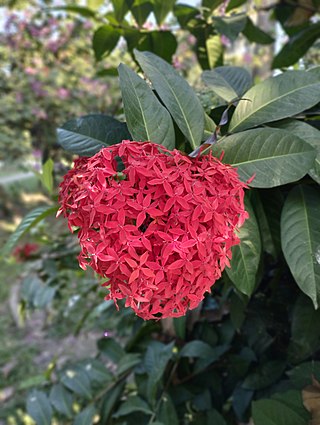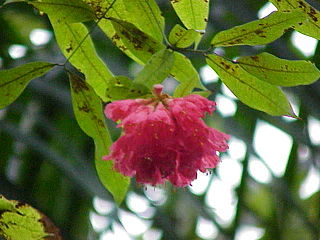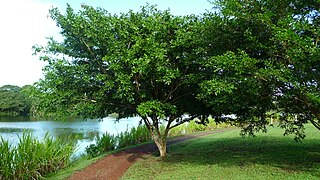
Mirabilis is a genus of plants in the family Nyctaginaceae known as the four-o'clocks or umbrellaworts. The best known species may be Mirabilis jalapa, the plant most commonly called four o'clock.

Stachys is a genus of plants, one of the largest in the mint family Lamiaceae. Estimates of the number of species vary from about 300, to about 450. Stachys is in the subfamily Lamioideae and its type species is Stachys sylvatica. The precise extent of the genus and its relationship to other genera in the subfamily are poorly known.

Sesbania is a genus of flowering plants in the pea family, Fabaceae, and the only genus found in tribe Sesbanieae. Riverhemp is a common name for plants in this genus. Notable species include the rattlebox, spiny sesbania, and Sesbania sesban, which is used in cooking. Plants of this genus, some of which are aquatic, can be used in alley cropping to increase the soil's nitrogen content. The species of rhizobia responsible for nitrogen fixation in Sesbania rostrata is Azorhizobium caulinodans.

Aotus is an Australian genus of flowering plants, within the legume family Fabaceae. Aotus species, together with other species of the tribe Mirbelieae, are often called golden peas because of their distinctive small yellow flowers. They are endemic to Australia, occurring in all states except the Northern Territory. Aotus are evergreen species. Some are widely cultivated by gardeners for their ornamental value.

Calliandra is a genus of flowering plants in the pea family, Fabaceae, in the mimosoid clade of the subfamily Caesalpinioideae. It contains about 140 species that are native to tropical and subtropical regions of the Americas.

The plant tribe Phaseoleae is one of the subdivisions of the legume subfamily Faboideae, in the unranked NPAAA clade. This group includes many of the beans cultivated for human and animal food, most importantly from the genera Glycine, Phaseolus, and Vigna.

Hemiandra is a genus of nine species of flowering plants of the family Lamiaceae and is endemic to Western Australia. Plants in the genus Hemiandra are shrubs with sessile leaves arranged in opposite pairs, petals with five lobes arranged in two "lips" and the fruit a capsule usually containing four nuts.

Kennedia is a genus of thirteen species of flowering plants in the pea family Fabaceae and is endemic to Australia. Plants in this genus are prostrate or climbing perennials with trifoliate leaves and large, showy, pea-like flowers. There are species in all Australian states.

Ixora is a genus of flowering plants in the family Rubiaceae. It is the only genus in the tribe Ixoreae. It consists of tropical evergreen trees and shrubs and holds around 544 species. Though native to the tropical and subtropical areas throughout the world, its centre of diversity is in Tropical Asia. Ixora also grows commonly in subtropical climates in the United States, such as Florida where it is commonly known as West Indian jasmine.

Brownea is a genus of flowering plants in the pea family (Fabaceae), subfamily Detarioideae. The genus includes about 22 species native to tropical regions of the Americas. The species are shrubs and trees growing to 20 m tall. Species range from Honduras through southern Central America and northern South America to Peru and northern Brazil, and to Trinidad and Tobago and the Windward Islands in the Caribbean. Species are typically understorey trees or shrubs in lowland tropical rain forest.

Dimorphandra is a genus of legume in the family Fabaceae, subfamily Caesalpinioideae. It includes 26 species native to northern South America, ranging from Colombia and Venezuela to Bolivia, Paraguay, and southeastern Brazil.

Ormosia is a genus of legumes. 131 living species, mostly trees or large shrubs, are native to the tropical Americas, from southwestern Mexico to Bolivia and southern Brazil, to southern, southeastern, and eastern Asia, and to New Guinea and Queensland. Most are tropical, while some extend into temperate temperate regions of China. A few species are threatened by habitat destruction, while the Hainan ormosia is probably extinct already.

Zygia is a genus of flowering plants in the family Fabaceae. It includes 60 species of tres and shrubs native to the tropical Americas, from Southern Mexico and Cuba to northern Argentina. Typical habitats are tropical forest and coastal zones, generally below 900 meters elevation with a few species extending up to 2800 meters. It belongs to the mimosoid clade of the subfamily Caesalpinioideae.

Hemigenia is a genus of flowering plants in the mint family, Lamiaceae and is endemic to Australia where most species occur in Western Australia, although some are also found in New South Wales and Queensland. Plants in this genus are shrubs or bushes with simple leaves and tube-shaped flowers with the petals forming two "lips" - the upper one with two lobes and the lower one with three.
Cleobulia is a genus of flowering plants in the legume family, Fabaceae. It belongs to subfamily Faboideae. It includes four species of vines, lianas, or shrubs native to southwestern Mexico and Brazil. Habitats include Amazon rainforest, seasonally dry forest, and montane oak and pine forest.

Lumnitzera is an Indo-West Pacific mangrove genus in the family Combretaceae. An English common name is black mangrove. Lumnitzera, named after the German botanist, Stephan Lumnitzer (1750-1806), occurs in mangroves from East Africa to the Western Pacific, and northern Australia.

Eriope is a genus of plants in the family Lamiaceae, first described in 1833. It is native to South America, many of the species endemic to Brazil.
- Eriope alpestrisMart. ex Benth. - Minas Gerais
- Eriope anamariaeHarley - Bahia
- Eriope angustifoliaEpling - Minas Gerais
- Eriope arenariaHarley - Minas Gerais
- Eriope blanchetii(Benth.) Harley - northeastern Brazil
- Eriope complicataMart. ex Benth. - Brazil
- Eriope confusaHarley - Bahia
- Eriope crassifoliaMart. ex Benth. - Bahia
- Eriope crassipesBenth. - Brazil, Paraguay, Venezuela, French Guiana, Bolivia, Colombia
- Eriope exaltataHarley - Bahia
- Eriope filifoliaBenth. - Minas Gerais
- Eriope foetidaA.St.-Hil. ex Benth. - Brazil
- Eriope glandulosa(Harley) Harley - Bahia, Minas Gerais
- Eriope hypenioidesMart. ex Benth. - Bahia
- Eriope hypoleuca(Benth.) Harley - Bahia, Minas Gerais
- Eriope latifolia(Mart. ex Benth.) Harley - eastern Brazil
- Eriope luetzelburgiiHarley - Bahia
- Eriope machrisae(Epling) Harley - Goiás
- Eriope macrostachyaMart. ex Benth. - Brazil, Paraguay, Venezuela
- Eriope montanaHarley - Bahia
- Eriope monticolaMart. ex Benth. - Bahia
- Eriope obovataEpling - northeastern Brazil
- Eriope parvifoliaMart. ex Benth. - Brazil
- Eriope polyphyllaMart. ex Benth. - Bahia
- Eriope salviifolia(Pohl ex Benth.) Harley - Bahia, Minas Gerais
- Eriope sincoranaHarley - Bahia
- Eriope tumidicaulisHarley - Bahia
- Eriope velutinaEpling - Brazil
- Eriope xavantiumHarley - Mato Grosso

Solenophora is a genus of flowering plants in the family Gesneriaceae, native to Central America and southern Mexico. Most of its species have limited, local distributions, but Solenophora calycosa is widespread.
Bionia is a small genus of flowering plants in the family Fabaceae, subfamily Faboideae, native to central and eastern Brazil. It was resurrected from Camptosema.




















